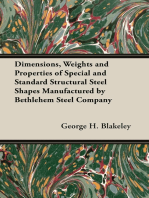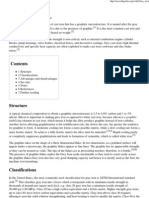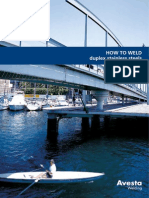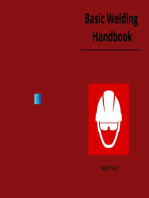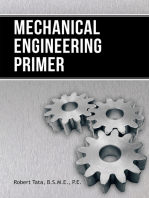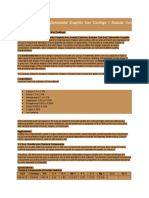0 ratings0% found this document useful (0 votes)
170 viewsCast Iron Vs Ductile Iron
Cast Iron Vs Ductile Iron
Uploaded by
Fekre RaziCast iron and ductile iron are commonly used materials for industrial gearbox housings. Cast iron provides good strength, machinability, and corrosion resistance at a low cost but can be brittle. Ductile iron has a rounded grain structure that gives it higher toughness and fatigue strength, making it better for applications with shock or impact loading, though it has a slightly higher cost. The document discusses specifications and properties of cast iron grades FC200 and FC250 and ductile iron grade FCD450 according to Japanese and American standards.
Copyright:
© All Rights Reserved
Available Formats
Download as PDF, TXT or read online from Scribd
Cast Iron Vs Ductile Iron
Cast Iron Vs Ductile Iron
Uploaded by
Fekre Razi0 ratings0% found this document useful (0 votes)
170 views2 pagesCast iron and ductile iron are commonly used materials for industrial gearbox housings. Cast iron provides good strength, machinability, and corrosion resistance at a low cost but can be brittle. Ductile iron has a rounded grain structure that gives it higher toughness and fatigue strength, making it better for applications with shock or impact loading, though it has a slightly higher cost. The document discusses specifications and properties of cast iron grades FC200 and FC250 and ductile iron grade FCD450 according to Japanese and American standards.
Original Description:
The comparison material
Original Title
Cast Iron vs Ductile Iron
Copyright
© © All Rights Reserved
Available Formats
PDF, TXT or read online from Scribd
Share this document
Did you find this document useful?
Is this content inappropriate?
Cast iron and ductile iron are commonly used materials for industrial gearbox housings. Cast iron provides good strength, machinability, and corrosion resistance at a low cost but can be brittle. Ductile iron has a rounded grain structure that gives it higher toughness and fatigue strength, making it better for applications with shock or impact loading, though it has a slightly higher cost. The document discusses specifications and properties of cast iron grades FC200 and FC250 and ductile iron grade FCD450 according to Japanese and American standards.
Copyright:
© All Rights Reserved
Available Formats
Download as PDF, TXT or read online from Scribd
Download as pdf or txt
0 ratings0% found this document useful (0 votes)
170 views2 pagesCast Iron Vs Ductile Iron
Cast Iron Vs Ductile Iron
Uploaded by
Fekre RaziCast iron and ductile iron are commonly used materials for industrial gearbox housings. Cast iron provides good strength, machinability, and corrosion resistance at a low cost but can be brittle. Ductile iron has a rounded grain structure that gives it higher toughness and fatigue strength, making it better for applications with shock or impact loading, though it has a slightly higher cost. The document discusses specifications and properties of cast iron grades FC200 and FC250 and ductile iron grade FCD450 according to Japanese and American standards.
Copyright:
© All Rights Reserved
Available Formats
Download as PDF, TXT or read online from Scribd
Download as pdf or txt
You are on page 1of 2
EDOC1-12-004
www.smcyclo.com Author: D.Rosseljong; Review: T.Bobak
The Relative Merits of Cast Iron Housings
Various grades of cast iron have been widely applied and used in a multitude of industrial machinery for many years. The use of cast iron as
a housing material in gearboxes of all sizes and configurations has been especially prevalent. That trend continues today, with the majority
of the medium to large reducer housings being made of cast iron.
The reasons for the pre-eminence of cast iron, as a reducer housing material, are many, including:
1) Structural rigidity,
2) High strength, especially in compression,
3) Good strength to weight ratio,
4) High machinability,
5) Corrosion resistance,
6) Inherently sound absorbing,
7) Excellent castability, making it easy to cast into complex shapes with simple and inexpensive patterns and
8) Relative abundance or raw materials.
The different grades of iron are named by their chemistry and their strength. For example, in the USA, Grey Cast Iron, Grade 30 is a specific
chemical composition, processed in a manner to obtain yield strength of 30,000 psi. Cast irons in grades 20 and 30 are the materials most
frequently specified in the construction of reducer housings.
Where greater strength for more demanding applications is required, it is possible to adjust the chemistry and the iron making process to
obtain a much stronger material: Ductile Iron. Ductile iron is typically twice as strong as many grey cast irons, and nearly as strong as
steel. While ductile iron shares many of the advantages of cast iron, the ductile iron is more difficult to cast, and has a different shrink rate
than cast iron. This difference means different patterns are required.
In the case of Sumitomo, because we are a subsidiary of a Japanese company, we
use a classification system called the Japanese Industrial System (JIS) to classify
many things including metals. In the Cyclo products, and their derivatives, cast iron
grade uses is typically FC200 (Figure 1), with the ductile iron being FCD450 (Figure 2).
Casting Materials
Casting material properties have been standardized by global industrial societies, such as JIS (Japan Industrial Standards) and ASTM
(American Society for Testing and Materials). Tensile strength is the defining characteristic of (Grey) cast iron and the grade is cited in the
name of the material (refer to the material properties below to understand the relationship). The two grades that Sumitomo uses are
identified below.
> Grey Cast Iron
FC200 (BBB5 Standard*)
200 N/mm
2
Tensile Strength
ASTM A48 Class No. 35 (equivalent)
35,000psi Tensile Strength
JIS Specification:
FC250 (equivalent)
250 N/mm
2
Tensile Strength
Sumitomo Specification:
ASTM A48 Class No. 40 (equivalent)
40,000psi Tensile Strength
* BBB5 Size-Z housing material is tempered die-cast aluminum JIS AC4C-T6(Standard) or ASTM B26-536-T6 (equivalent)
Each standard has slight variations, and due to conversions, we can say: FC200 < A48 No.35 < FC250 < A48 No.40. Elongation of the material
or the ability to flex is the defining characteristic of ductile (nodular) iron. Ductile iron grades can be classified from the variations in the
tensile strength, yield strength, and the elongation. Elongation is the % of stretch of a 2 or 50mm sample and it is important enough to be
identified in the different material grades (shown as the suffix in each grade). The ASTM (Sumitomo) specification readily identifies the
tensile, yield and % elongation respectively, in the grade.
> Ductile Iron
JIS Specification:
FCD450-10 (BBB4 Standard)
10% elongation
Sumitomo Specification:
ASTM A536-65-45-12 (equivalent)
65ksi Tensile; 45ksi Yield; 12% elongation
Cast Iron vs. Ductile Iron Housing Material
Figure 1. Cast Iron Example Figure 2. Ductile Iron Example
Click here to Configure
EDOC1-12-004
www.smcyclo.com Author: D.Rosseljong; Review: T.Bobak
The housing material can be identified directly inside the housing through raised cast lettering. FCD will indicate Ductile Iron and FC
will indicate Cast Iron (See Figures 1 and 2).
When the grain is viewed under a microscope, ductile iron has a spheroidal shape where the cast iron reveals a flaky composition.
Refer to Figures 3 and 4. These rounded shapes allow for more flexibility. The grain structure difference helps to define the strengths
and weakness of each material.
Material Properties Strengths Weakness
Cast
Iron
Tensile
FC200 200 N/mm
2
[29,008psi]
FC250 250 N/mm
2
[36,259psi]
A48 No.35 35,000psi [241 N/mm
2
]
A48 No.40 40,000psi [275 N/mm
2
]
High Strength/Weight
Low Production Cost
High Machinability
Vibration Dampening
Excellent up to moderate shock loading
Superior compressive strength compared to
steel
Lower tensile strength compared to steel
More brittle compared to ductile or steel
when used for shock loaded applications
Temperatures below 30F/ 0C are
susceptible to thermal/impact shock and
brittle failure.
Ductile
Iron
Tensile
FCD450 450 N/mm
2
[65,260 psi]
A536 65-45-12 65,000psi [448 N/mm
2
]
Yield
FCD450 280 N/mm
2
[40,610 psi]
A536 65-45-12 45,000psi [310 N/mm
2
]
Elongation
FCD450-10 > 10% A536 65-45-12 > 12%
High Fracture Toughness (Ability to resist
fracturing) when compared to cast iron)
High Fatigue Strength compared to cast iron
High Machinability
Vibration Dampening
Excellent for shock and impact loading
Similar casting/pouring properties to cast
iron
Excellent cost / ratings improvement
Slightly higher coefficient of expansion than
cast iron.
Slightly lower machinability compared to
cast iron.
Only slightly higher brittleness from cast
iron below -25C (-13F)
References:
J.R. Davis, ASM Specialty Handbook, Cast Irons, ASM International, 1996 E. Oberg, et.al, Machinerys Handbook, 25th Edition, Industrial Press, Inc. New York, 1996
H.E. Boyer, T.L. Gall, Metals Handbook, Desk Edition, American Society for Metals, 1985 Metals data book, Japanese Standards Association, Tokyo, Japan, 1984
Figure 3. Ductile (nodular) Iron Grain Structure
Figure 4. Grey Cast Iron Grain Structure
Photos c/o http://physicsarchives.com
Cast Iron vs. Ductile Iron Housing Material (Continued)
Click here to Configure
You might also like
- S.G.Iron GuidelinesDocument28 pagesS.G.Iron GuidelinesTarun Chakraborty100% (3)
- Project Report On Ductile PipeDocument8 pagesProject Report On Ductile PipeEIRI Board of Consultants and Publishers100% (1)
- Dimensions, Weights and Properties of Special and Standard Structural Steel Shapes Manufactured by Bethlehem Steel CompanyFrom EverandDimensions, Weights and Properties of Special and Standard Structural Steel Shapes Manufactured by Bethlehem Steel CompanyNo ratings yet
- Cast Iron Vs Ductile IronDocument2 pagesCast Iron Vs Ductile IronJayakrishnan RadhakrishnanNo ratings yet
- Arc Welding Specific SteelsDocument169 pagesArc Welding Specific Steelsmario fisgaNo ratings yet
- Arc Welding of Specific Steels and Cast Irons: Fourth EditionDocument170 pagesArc Welding of Specific Steels and Cast Irons: Fourth EditionDiNo ratings yet
- Arc Welding of Specific Steels and Cast Irons: Fourth EditionDocument170 pagesArc Welding of Specific Steels and Cast Irons: Fourth EditionJose Luis Chapas100% (1)
- Stell 2011specificDocument7 pagesStell 2011specificninatenaNo ratings yet
- Structural-SteelDocument37 pagesStructural-SteelJoseph John RodriguezNo ratings yet
- Maraging SteelDocument4 pagesMaraging SteelJayanthiANo ratings yet
- HighPerformance Steel (ForBridgeConstrunction) enDocument38 pagesHighPerformance Steel (ForBridgeConstrunction) enDavid CrownNo ratings yet
- 2011specific Kobelco BookDocument169 pages2011specific Kobelco Bookmas_munir7174No ratings yet
- Rebar Steel Bar Detail For Grade 1Document29 pagesRebar Steel Bar Detail For Grade 1talatzahoorNo ratings yet
- A Review of High-Strength Wear-Resistant Steel-HardoxDocument8 pagesA Review of High-Strength Wear-Resistant Steel-HardoxakhileshNo ratings yet
- Design - Ring Gear MaterialsDocument4 pagesDesign - Ring Gear Materialstushar11singhNo ratings yet
- Ferro Fundido CinzentoDocument3 pagesFerro Fundido CinzentoCarlos LaoNo ratings yet
- En 10025Document16 pagesEn 10025Sorin Radu67% (3)
- Grey IronDocument3 pagesGrey IronRajesh N Priya Gopinathan100% (1)
- What Is Rebar?: Grades of Rebar in Different CodesDocument9 pagesWhat Is Rebar?: Grades of Rebar in Different CodesSalih MohayaddinNo ratings yet
- Introduction To DSS and Connections-Converted-1Document85 pagesIntroduction To DSS and Connections-Converted-1Vaheed ShaikNo ratings yet
- Investigation Into The Strength Characteristics of Reinforcement Steel Rods in Sokoto Market, Sokoto State NigeriaDocument4 pagesInvestigation Into The Strength Characteristics of Reinforcement Steel Rods in Sokoto Market, Sokoto State NigeriaInternational Journal of Latest Research in Engineering and TechnologyNo ratings yet
- Designing With Ductile IronDocument4 pagesDesigning With Ductile IronCarlos LaoNo ratings yet
- Cast IronDocument5 pagesCast IronPetroenNo ratings yet
- Unit 3Document14 pagesUnit 3rakesh guptaNo ratings yet
- Structural SteelDocument5 pagesStructural Steelrdx6zqftnrNo ratings yet
- AVESTA How To Weld Duplex SteelDocument20 pagesAVESTA How To Weld Duplex SteelGMacella100% (1)
- Aar603 StructureDocument9 pagesAar603 StructureMUHAMMAD AQIL BIN RAMLINo ratings yet
- P434 Stainless Steel Bridges Dec 2021 USDocument4 pagesP434 Stainless Steel Bridges Dec 2021 USAkshay GamreNo ratings yet
- Detailing of Reinforcement in Concrete Structures Volume 1Document244 pagesDetailing of Reinforcement in Concrete Structures Volume 1Ahmed Refaey100% (6)
- A Study On Fatigue Durability of RC Slab With Metal-Grid Instead of Steel Re-BarDocument12 pagesA Study On Fatigue Durability of RC Slab With Metal-Grid Instead of Steel Re-BarTrầmLãngNo ratings yet
- The Modulus of Elasticity of Steel - Is It 200 GPaDocument9 pagesThe Modulus of Elasticity of Steel - Is It 200 GPaRevanth KumarNo ratings yet
- Hiten Kadu 6.1Document104 pagesHiten Kadu 6.1Pranjal DograNo ratings yet
- 1.2 Mechanical Design: 1.2.1 Material Selection Based On Corrosion ResistanceDocument12 pages1.2 Mechanical Design: 1.2.1 Material Selection Based On Corrosion ResistanceYusuf Shano100% (1)
- TMT BarsDocument26 pagesTMT BarsPardeep KushwahaNo ratings yet
- AVESTA POLARIT - Stainless Steels - Their Properties and Their Suitability For WeldingDocument11 pagesAVESTA POLARIT - Stainless Steels - Their Properties and Their Suitability For Weldingmirza_adil99No ratings yet
- Advanced High Strength SteelsDocument24 pagesAdvanced High Strength SteelsPrasanth SoundappanNo ratings yet
- What Is Steel Reinforcement? Why Is It Required in A Concrete Structure?Document11 pagesWhat Is Steel Reinforcement? Why Is It Required in A Concrete Structure?Rabish ANo ratings yet
- What Is Steel Reinforcement? Why Is It Required in A Concrete Structure?Document11 pagesWhat Is Steel Reinforcement? Why Is It Required in A Concrete Structure?Jesse RodriguezNo ratings yet
- SUJDocument11 pagesSUJamit2688No ratings yet
- Type of ReinforcementDocument3 pagesType of ReinforcementKartik JainNo ratings yet
- Bolted ConnectionsDocument83 pagesBolted Connections22ce100jinsNo ratings yet
- Chapter 1 Introd-Steel Struc.Document4 pagesChapter 1 Introd-Steel Struc.Eng Abdikarim WalhadNo ratings yet
- Cast IronDocument6 pagesCast IronRaja Sekaran SajjaNo ratings yet
- Defects in SteelDocument16 pagesDefects in SteelAasim AzmiNo ratings yet
- Varieties of SG IRONDocument3 pagesVarieties of SG IRONKharade RajendraNo ratings yet
- Study of Mechanical Properties of The Available Brands of Steel Reinforcement in Kurdistan IraqDocument10 pagesStudy of Mechanical Properties of The Available Brands of Steel Reinforcement in Kurdistan IraqIAEME PublicationNo ratings yet
- Sheet Metalwork on the Farm - Containing Information on Materials, Soldering, Tools and Methods of Sheet MetalworkFrom EverandSheet Metalwork on the Farm - Containing Information on Materials, Soldering, Tools and Methods of Sheet MetalworkNo ratings yet
- Forging - Manual of Practical Instruction in Hand Forging of Wrought Iron, Machine Steel and Tool Steel; Drop Forging; and Heat Treatment of Steel, Including Annealing, Hardening and TemperingFrom EverandForging - Manual of Practical Instruction in Hand Forging of Wrought Iron, Machine Steel and Tool Steel; Drop Forging; and Heat Treatment of Steel, Including Annealing, Hardening and TemperingRating: 5 out of 5 stars5/5 (1)
- Oxy-Acetylene Welding and Cutting: Electric, Forge and Thermit Welding together with related methods and materials used in metal working and the oxygen process for removal of carbonFrom EverandOxy-Acetylene Welding and Cutting: Electric, Forge and Thermit Welding together with related methods and materials used in metal working and the oxygen process for removal of carbonNo ratings yet
- Standard Blacksmithing, Horseshoeing and Wagon Making: Containing: Twelve Lessons in Elementary Blacksmithing Adapted to the Demand of Schools and Colleges of Mechanic Arts: Tables, Rules and Receipts Useful to Manufactures, Machinists, Engineers and BlacksmithsFrom EverandStandard Blacksmithing, Horseshoeing and Wagon Making: Containing: Twelve Lessons in Elementary Blacksmithing Adapted to the Demand of Schools and Colleges of Mechanic Arts: Tables, Rules and Receipts Useful to Manufactures, Machinists, Engineers and BlacksmithsNo ratings yet
- Heat-Treatment of Steel: A Comprehensive Treatise on the Hardening, Tempering, Annealing and Casehardening of Various Kinds of Steel: Including High-speed, High-Carbon, Alloy and Low Carbon Steels, Together with Chapters on Heat-Treating Furnaces and on Hardness TestingFrom EverandHeat-Treatment of Steel: A Comprehensive Treatise on the Hardening, Tempering, Annealing and Casehardening of Various Kinds of Steel: Including High-speed, High-Carbon, Alloy and Low Carbon Steels, Together with Chapters on Heat-Treating Furnaces and on Hardness TestingRating: 1 out of 5 stars1/5 (1)
- Hand-Forging and Wrought-Iron Ornamental WorkFrom EverandHand-Forging and Wrought-Iron Ornamental WorkRating: 5 out of 5 stars5/5 (1)
- MIDA - GD SPM ManufacturerDocument3 pagesMIDA - GD SPM ManufacturerFekre RaziNo ratings yet
- ATS Company Profile 1Document20 pagesATS Company Profile 1Fekre RaziNo ratings yet
- ATS Oilfield Supply & ServicesDocument3 pagesATS Oilfield Supply & ServicesFekre RaziNo ratings yet
- Report Overhang2Document6 pagesReport Overhang2Fekre RaziNo ratings yet
- Steve JobsDocument6 pagesSteve JobsFekre RaziNo ratings yet
- Bollards Marine SystemsDocument48 pagesBollards Marine Systemsipman99100% (1)
- 1 Chapter 1.1 Engineering Materilas (Metals,... )Document39 pages1 Chapter 1.1 Engineering Materilas (Metals,... )KidusNo ratings yet
- Effect of Basic Chemical Element in Sgi Ductile Iron IJERTV1IS7135Document7 pagesEffect of Basic Chemical Element in Sgi Ductile Iron IJERTV1IS7135Uma KoduriNo ratings yet
- Equivalent Grades of Gray Iron, Ductile Iron, SG Iron, Nodular Graphite IronDocument2 pagesEquivalent Grades of Gray Iron, Ductile Iron, SG Iron, Nodular Graphite IronBao Duy Nguyen100% (3)
- Creating Value: Jai Balaji GroupDocument8 pagesCreating Value: Jai Balaji GroupAkshat Engineers Private LimitedNo ratings yet
- Metallurgy Lecture NotesDocument103 pagesMetallurgy Lecture Notesفرح تامرNo ratings yet
- Valve Pressure DropDocument4 pagesValve Pressure DropEldiyar AzamatovNo ratings yet
- Meyer Nicholas ThesisDocument207 pagesMeyer Nicholas ThesisDaniel CoelhoNo ratings yet
- Elkem 07 Magnesiun Contents in Ductile IronDocument2 pagesElkem 07 Magnesiun Contents in Ductile Ironmarcotulio123No ratings yet
- SG Iron Charts2Document4 pagesSG Iron Charts2bbaskaran100% (3)
- CG IronDocument14 pagesCG IronRahul KhoslaNo ratings yet
- Casting Materials 2015Document43 pagesCasting Materials 2015Alex EnciuNo ratings yet
- Bollard Guide TrelleborgDocument9 pagesBollard Guide Trelleborgcost_engineer100% (2)
- Welding Cast IronDocument10 pagesWelding Cast IronRoberto CordovaNo ratings yet
- Trelleborg Bollard GuideDocument9 pagesTrelleborg Bollard Guidenmh43No ratings yet
- Casting Material Austenitic Ductile Iron in ASTM A439Document3 pagesCasting Material Austenitic Ductile Iron in ASTM A439Alex007No ratings yet
- Neco Catlog 4 FoldDocument2 pagesNeco Catlog 4 FoldSanket PhatangareNo ratings yet
- En Gjs 500 7 SG IronDocument3 pagesEn Gjs 500 7 SG Ironsteepenwolf82No ratings yet
- Types of Cast IronDocument5 pagesTypes of Cast Ironmanas310jntuhNo ratings yet
- Lecture 1 - Part II - Engineering MaterialsDocument39 pagesLecture 1 - Part II - Engineering MaterialsZainab MalikNo ratings yet
- Heat Treatment S.G IronDocument58 pagesHeat Treatment S.G IronShafiqul Chowdhury100% (2)
- SG Iron ProductionDocument20 pagesSG Iron ProductionShreyashri Nayak100% (1)
- Chunky GraphiteDocument16 pagesChunky GraphitesachinguptachdNo ratings yet
- EMAT Module 1Document19 pagesEMAT Module 1JUSTINE AngelesNo ratings yet
- D.I. Catalogue) 9th Edition) PDFDocument70 pagesD.I. Catalogue) 9th Edition) PDFArunprasad MurugesanNo ratings yet
- II Year Emm Edited PDFDocument91 pagesII Year Emm Edited PDFMECHANICAL SMCETNo ratings yet
- Srikalahashti Pipes Company ProfileDocument14 pagesSrikalahashti Pipes Company ProfilemaheshsNo ratings yet
- AIPSI - Kebutuhan Stainless Steel Untuk Konsummsi Dalam Negeri Industri Pompa 1 Okt 2024Document25 pagesAIPSI - Kebutuhan Stainless Steel Untuk Konsummsi Dalam Negeri Industri Pompa 1 Okt 2024Yohanes KurniawanNo ratings yet
- Composition and Grades of Cast IronDocument5 pagesComposition and Grades of Cast IronahmedNo ratings yet


